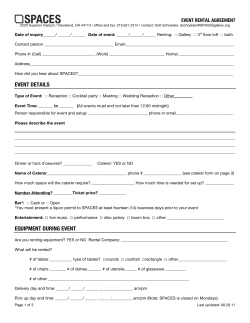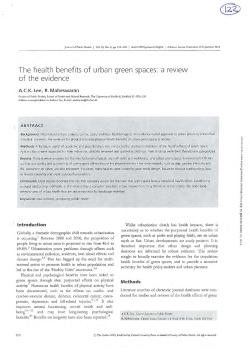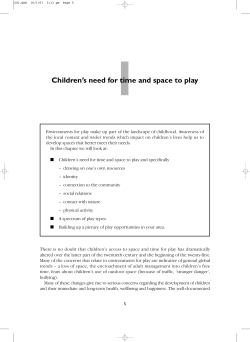
MATH 105: Finite Mathematics 7-1: Sample Spaces and Assignment of Probability
Probability
Sample Spaces
Assigning Probability
Conclusion
MATH 105: Finite Mathematics
7-1: Sample Spaces and Assignment of Probability
Prof. Jonathan Duncan
Walla Walla College
Winter Quarter, 2006
Probability
Sample Spaces
Outline
1
Probability
2
Sample Spaces
3
Assigning Probability
4
Conclusion
Assigning Probability
Conclusion
Probability
Sample Spaces
Outline
1
Probability
2
Sample Spaces
3
Assigning Probability
4
Conclusion
Assigning Probability
Conclusion
Probability
Sample Spaces
Assigning Probability
Conclusion
Introduction to Probability
Many real world events can be considered chance or random. They
may be deterministic, but we can not know or comprehend all the
factors which determine the outcome.
Example
You flip a coin. Air current, the arrangement of the coin on your
finger, the force of your flip, and other factors all go together to
determine the outcome of Heads or Tails.
For any one toss, these factors are too complicated to take into
account, and the outcome appears random. Since the outcome is
heads roughly half the time, we assign the following probabilities:
Pr [H] =
1
2
Pr [T ] =
1
2
Probability
Sample Spaces
Assigning Probability
Conclusion
Introduction to Probability
Many real world events can be considered chance or random. They
may be deterministic, but we can not know or comprehend all the
factors which determine the outcome.
Example
You flip a coin. Air current, the arrangement of the coin on your
finger, the force of your flip, and other factors all go together to
determine the outcome of Heads or Tails.
For any one toss, these factors are too complicated to take into
account, and the outcome appears random. Since the outcome is
heads roughly half the time, we assign the following probabilities:
Pr [H] =
1
2
Pr [T ] =
1
2
Probability
Sample Spaces
Assigning Probability
Probability Vocabulary
Probability Terms
Outcome
A particular result of an activity or event.
Event
A set of outcomes which share a common characteristic.
Sample Space
The set of all possible outcomes for an experiment. This is
the universal set for the experiment.
Equally Likely Events
All events in the sample space have the same probability.
Conclusion
Probability
Sample Spaces
Assigning Probability
Probability Vocabulary
Probability Terms
Outcome
A particular result of an activity or event.
Event
A set of outcomes which share a common characteristic.
Sample Space
The set of all possible outcomes for an experiment. This is
the universal set for the experiment.
Equally Likely Events
All events in the sample space have the same probability.
Conclusion
Probability
Sample Spaces
Assigning Probability
Probability Vocabulary
Probability Terms
Outcome
A particular result of an activity or event.
Event
A set of outcomes which share a common characteristic.
Sample Space
The set of all possible outcomes for an experiment. This is
the universal set for the experiment.
Equally Likely Events
All events in the sample space have the same probability.
Conclusion
Probability
Sample Spaces
Assigning Probability
Probability Vocabulary
Probability Terms
Outcome
A particular result of an activity or event.
Event
A set of outcomes which share a common characteristic.
Sample Space
The set of all possible outcomes for an experiment. This is
the universal set for the experiment.
Equally Likely Events
All events in the sample space have the same probability.
Conclusion
Probability
Sample Spaces
Assigning Probability
Probability Vocabulary
Probability Terms
Outcome
A particular result of an activity or event.
Event
A set of outcomes which share a common characteristic.
Sample Space
The set of all possible outcomes for an experiment. This is
the universal set for the experiment.
Equally Likely Events
All events in the sample space have the same probability.
Conclusion
Probability
Sample Spaces
Outline
1
Probability
2
Sample Spaces
3
Assigning Probability
4
Conclusion
Assigning Probability
Conclusion
Probability
Sample Spaces
Assigning Probability
Conclusion
Finding Sample Spaces
One of the first tasks in finding probability is to determine the
sample space for the experiment.
Example
You flip a fair coin. What is the sample space for this experiment?
Example
You roll a six-sided die and note the number which appears on top.
What is the sample space for this experiment?
Probability
Sample Spaces
Assigning Probability
Conclusion
Finding Sample Spaces
One of the first tasks in finding probability is to determine the
sample space for the experiment.
Example
You flip a fair coin. What is the sample space for this experiment?
Example
You roll a six-sided die and note the number which appears on top.
What is the sample space for this experiment?
Probability
Sample Spaces
Assigning Probability
Conclusion
Finding Sample Spaces
One of the first tasks in finding probability is to determine the
sample space for the experiment.
Example
You flip a fair coin. What is the sample space for this experiment?
S = {H, T }
Example
You roll a six-sided die and note the number which appears on top.
What is the sample space for this experiment?
Probability
Sample Spaces
Assigning Probability
Conclusion
Finding Sample Spaces
One of the first tasks in finding probability is to determine the
sample space for the experiment.
Example
You flip a fair coin. What is the sample space for this experiment?
S = {H, T }
Example
You roll a six-sided die and note the number which appears on top.
What is the sample space for this experiment?
Probability
Sample Spaces
Assigning Probability
Conclusion
Finding Sample Spaces
One of the first tasks in finding probability is to determine the
sample space for the experiment.
Example
You flip a fair coin. What is the sample space for this experiment?
S = {H, T }
Example
You roll a six-sided die and note the number which appears on top.
What is the sample space for this experiment?
S = {1, 2, 3, 4, 5, 6}
Probability
Sample Spaces
Assigning Probability
Conclusion
Finding More Sample Spaces
Example
You flip a coin and roll a die, and note the result of each. what is
the sample space for this experiment?
S = {H1, H2, . . ., H6, T 1, T 2, . . ., T 6}
c(S) = 2 · 6 = 12
Probability
Sample Spaces
Assigning Probability
Conclusion
Finding More Sample Spaces
Example
You flip a coin and roll a die, and note the result of each. what is
the sample space for this experiment?
S = {H1, H2, . . ., H6, T 1, T 2, . . ., T 6}
c(S) = 2 · 6 = 12
Probability
Sample Spaces
Assigning Probability
Conclusion
Finding More Sample Spaces
Example
You flip a coin and roll a die, and note the result of each. what is
the sample space for this experiment?
S = {H1, H2, . . ., H6, T 1, T 2, . . ., T 6}
c(S) = 2 · 6 = 12
Probability
Sample Spaces
Assigning Probability
Different Sample Spaces for the Same Experiment
Example
You roll two dice and note both numbers. What is the sample
space for this experiment?
Example
You roll two dice and note the sum of the two numbers. What is
the sample space for this experiment?
Conclusion
Probability
Sample Spaces
Assigning Probability
Different Sample Spaces for the Same Experiment
Example
You roll two dice and note both numbers. What is the sample
space for this experiment?
S = {(1, 1), (1, 2), . . ., (2, 1), (2, 2), . . .} c(S) = 6 · 6 = 36
Example
You roll two dice and note the sum of the two numbers. What is
the sample space for this experiment?
Conclusion
Probability
Sample Spaces
Assigning Probability
Different Sample Spaces for the Same Experiment
Example
You roll two dice and note both numbers. What is the sample
space for this experiment?
S = {(1, 1), (1, 2), . . ., (2, 1), (2, 2), . . .} c(S) = 6 · 6 = 36
Example
You roll two dice and note the sum of the two numbers. What is
the sample space for this experiment?
Conclusion
Probability
Sample Spaces
Assigning Probability
Different Sample Spaces for the Same Experiment
Example
You roll two dice and note both numbers. What is the sample
space for this experiment?
S = {(1, 1), (1, 2), . . ., (2, 1), (2, 2), . . .} c(S) = 6 · 6 = 36
Example
You roll two dice and note the sum of the two numbers. What is
the sample space for this experiment?
S = {2, 3, . . ., 12}
c(S) = 11
Conclusion
Probability
Sample Spaces
Assigning Probability
Conclusion
Taking a Quiz
Example
You take a True/False quiz with three questions. If you treat this
quiz as an experiment, what is the sample space?
Probability
Sample Spaces
Assigning Probability
Conclusion
Taking a Quiz
Example
You take a True/False quiz with three questions. If you treat this
quiz as an experiment, what is the sample space?
S = {TTT , TTF , . . ., FFF }
c(S) = 8
Probability
Sample Spaces
Assigning Probability
Conclusion
Taking a Quiz
Example
You take a True/False quiz with three questions. If you treat this
quiz as an experiment, what is the sample space?
S = {TTT , TTF , . . ., FFF }
c(S) = 8
Now that we have some practice identifying sample spaces, it is time
to start assigning probabilities.
Probability
Sample Spaces
Outline
1
Probability
2
Sample Spaces
3
Assigning Probability
4
Conclusion
Assigning Probability
Conclusion
Probability
Sample Spaces
Assigning Probability
Conclusion
Taking a Quiz
Example
How likely are you to get all three answers in the True/False quiz
correct if you guess on each question?
Rules for Assigning Probability
For each outcome W , 0 ≤ Pr [W ] ≤ 1
The sum of the probabilities of all outcomes is one.
Equally Likely Outcomes
Pr [TTT ] = Pr [TTF ] = . . . = Pr [FFF ] =
1
1
=
c(S)
8
Probability
Sample Spaces
Assigning Probability
Conclusion
Taking a Quiz
Example
How likely are you to get all three answers in the True/False quiz
correct if you guess on each question?
S = {TTT , TTF , TFT , TFF , FTT , FTF , FFT , FFF }
Rules for Assigning Probability
For each outcome W , 0 ≤ Pr [W ] ≤ 1
The sum of the probabilities of all outcomes is one.
Equally Likely Outcomes
Pr [TTT ] = Pr [TTF ] = . . . = Pr [FFF ] =
1
1
=
c(S)
8
Probability
Sample Spaces
Assigning Probability
Conclusion
Taking a Quiz
Example
How likely are you to get all three answers in the True/False quiz
correct if you guess on each question?
S = {TTT , TTF , TFT , TFF , FTT , FTF , FFT , FFF }
A few rules before we actually assign probabilities.
Rules for Assigning Probability
For each outcome W , 0 ≤ Pr [W ] ≤ 1
The sum of the probabilities of all outcomes is one.
Equally Likely Outcomes
Pr [TTT ] = Pr [TTF ] = . . . = Pr [FFF ] =
1
1
=
c(S)
8
Probability
Sample Spaces
Assigning Probability
Conclusion
Taking a Quiz
Example
How likely are you to get all three answers in the True/False quiz
correct if you guess on each question?
S = {TTT , TTF , TFT , TFF , FTT , FTF , FFT , FFF }
A few rules before we actually assign probabilities.
Rules for Assigning Probability
For each outcome W , 0 ≤ Pr [W ] ≤ 1
The sum of the probabilities of all outcomes is one.
Equally Likely Outcomes
Pr [TTT ] = Pr [TTF ] = . . . = Pr [FFF ] =
1
1
=
c(S)
8
Probability
Sample Spaces
Assigning Probability
Conclusion
Taking a Quiz
Example
How likely are you to get all three answers in the True/False quiz
correct if you guess on each question?
S = {TTT , TTF , TFT , TFF , FTT , FTF , FFT , FFF }
A few rules before we actually assign probabilities.
Rules for Assigning Probability
For each outcome W , 0 ≤ Pr [W ] ≤ 1
The sum of the probabilities of all outcomes is one.
Equally Likely Outcomes
Pr [TTT ] = Pr [TTF ] = . . . = Pr [FFF ] =
1
1
=
c(S)
8
Probability
Sample Spaces
Assigning Probability
Conclusion
Taking a Quiz
Example
How likely are you to get all three answers in the True/False quiz
correct if you guess on each question?
S = {TTT , TTF , TFT , TFF , FTT , FTF , FFT , FFF }
A few rules before we actually assign probabilities.
Rules for Assigning Probability
For each outcome W , 0 ≤ Pr [W ] ≤ 1
The sum of the probabilities of all outcomes is one.
Equally Likely Outcomes
Pr [TTT ] = Pr [TTF ] = . . . = Pr [FFF ] =
1
1
=
c(S)
8
Probability
Sample Spaces
Assigning Probability
Conclusion
Probability Model
When you find the sample space for an experiment and assign
probabilities to each element of the sample space, you are
constructing a probability model.
Example
A six sided die is weighted so that the 1 is twice as likely as any
other number and all other numbers are equally likely. Find the
probability model.
S ={
Pr [1] =
2
7
1,
2x
2,
x
3,
x
4,
x
5,
x
6,
x
}
Pr [2] = Pr [3] = Pr [4] = Pr [5] = Pr [6] =
1
7
Probability
Sample Spaces
Assigning Probability
Conclusion
Probability Model
When you find the sample space for an experiment and assign
probabilities to each element of the sample space, you are
constructing a probability model.
Example
A six sided die is weighted so that the 1 is twice as likely as any
other number and all other numbers are equally likely. Find the
probability model.
S ={
Pr [1] =
2
7
1,
2x
2,
x
3,
x
4,
x
5,
x
6,
x
}
Pr [2] = Pr [3] = Pr [4] = Pr [5] = Pr [6] =
1
7
Probability
Sample Spaces
Assigning Probability
Conclusion
Probability Model
When you find the sample space for an experiment and assign
probabilities to each element of the sample space, you are
constructing a probability model.
Example
A six sided die is weighted so that the 1 is twice as likely as any
other number and all other numbers are equally likely. Find the
probability model.
S ={
Pr [1] =
2
7
1,
2x
2,
x
3,
x
4,
x
5,
x
6,
x
}
Pr [2] = Pr [3] = Pr [4] = Pr [5] = Pr [6] =
1
7
Probability
Sample Spaces
Assigning Probability
Conclusion
Probability Model
When you find the sample space for an experiment and assign
probabilities to each element of the sample space, you are
constructing a probability model.
Example
A six sided die is weighted so that the 1 is twice as likely as any
other number and all other numbers are equally likely. Find the
probability model.
S ={
Pr [1] =
2
7
1,
2x
2,
x
3,
x
4,
x
5,
x
6,
x
}
Pr [2] = Pr [3] = Pr [4] = Pr [5] = Pr [6] =
1
7
Probability
Sample Spaces
Assigning Probability
Probabilities of Events
To find the probability of an event in sample spaces with equally
likely outcomes, we use the following probability formula.
Probability of an Event
If E is a subset of a sample space S in which all outcomes are
equally likely, then
c(E )
Pr [E ] =
c(S)
Example
You guess on all 3 questions in the True/False quiz seen earlier.
What is the probability that you miss one?
E = {TTF , TFT , FTT } Pr [E ] =
c(E )
3
=
c(S)
8
Conclusion
Probability
Sample Spaces
Assigning Probability
Probabilities of Events
To find the probability of an event in sample spaces with equally
likely outcomes, we use the following probability formula.
Probability of an Event
If E is a subset of a sample space S in which all outcomes are
equally likely, then
c(E )
Pr [E ] =
c(S)
Example
You guess on all 3 questions in the True/False quiz seen earlier.
What is the probability that you miss one?
E = {TTF , TFT , FTT } Pr [E ] =
c(E )
3
=
c(S)
8
Conclusion
Probability
Sample Spaces
Assigning Probability
Probabilities of Events
To find the probability of an event in sample spaces with equally
likely outcomes, we use the following probability formula.
Probability of an Event
If E is a subset of a sample space S in which all outcomes are
equally likely, then
c(E )
Pr [E ] =
c(S)
Example
You guess on all 3 questions in the True/False quiz seen earlier.
What is the probability that you miss one?
E = {TTF , TFT , FTT } Pr [E ] =
c(E )
3
=
c(S)
8
Conclusion
Probability
Sample Spaces
Assigning Probability
Probabilities of Events
To find the probability of an event in sample spaces with equally
likely outcomes, we use the following probability formula.
Probability of an Event
If E is a subset of a sample space S in which all outcomes are
equally likely, then
c(E )
Pr [E ] =
c(S)
Example
You guess on all 3 questions in the True/False quiz seen earlier.
What is the probability that you miss one?
E = {TTF , TFT , FTT } Pr [E ] =
c(E )
3
=
c(S)
8
Conclusion
Probability
Sample Spaces
Assigning Probability
Conclusion
Drawing Balls from an Urn
Example
A jar contains 8 balls: 4 green, 3 blue, and 1 red. You pick one
ball at random. Find:
1
The probability the ball you draw is green.
2
The probability the ball you draw is not red.
Example
An urn contains 3 balls: one red, one green, and one yellow. You
draw the balls out one-by-one at random. What is the probability
that the yellow ball is not drawn drawn last?
Probability
Sample Spaces
Assigning Probability
Conclusion
Drawing Balls from an Urn
Example
A jar contains 8 balls: 4 green, 3 blue, and 1 red. You pick one
ball at random. Find:
1
The probability the ball you draw is green.
2
The probability the ball you draw is not red.
Example
An urn contains 3 balls: one red, one green, and one yellow. You
draw the balls out one-by-one at random. What is the probability
that the yellow ball is not drawn drawn last?
Probability
Sample Spaces
Assigning Probability
Conclusion
Rolling Two Dice
Example
You roll two fair six-sided dice and note the sum of the rolls. Find
each probability.
1
Pr [ sum is 7 ]
2
Pr [ sum is 4 ]
3
Pr [ sum is 4 or 7 ]
4
Pr [ sum is 4 and 7 ]
Probability
Sample Spaces
Outline
1
Probability
2
Sample Spaces
3
Assigning Probability
4
Conclusion
Assigning Probability
Conclusion
Probability
Sample Spaces
Assigning Probability
Important Concepts
Things to Remember from Section 7-1
1
Probability Vocabulary: Outcomes, Events, Sample Spaces
2
Finding Sample Spaces
3
Building Probability Models
4
Assigning Probabilities to Events
Conclusion
Probability
Sample Spaces
Assigning Probability
Important Concepts
Things to Remember from Section 7-1
1
Probability Vocabulary: Outcomes, Events, Sample Spaces
2
Finding Sample Spaces
3
Building Probability Models
4
Assigning Probabilities to Events
Conclusion
Probability
Sample Spaces
Assigning Probability
Important Concepts
Things to Remember from Section 7-1
1
Probability Vocabulary: Outcomes, Events, Sample Spaces
2
Finding Sample Spaces
3
Building Probability Models
4
Assigning Probabilities to Events
Conclusion
Probability
Sample Spaces
Assigning Probability
Important Concepts
Things to Remember from Section 7-1
1
Probability Vocabulary: Outcomes, Events, Sample Spaces
2
Finding Sample Spaces
3
Building Probability Models
4
Assigning Probabilities to Events
Conclusion
Probability
Sample Spaces
Assigning Probability
Important Concepts
Things to Remember from Section 7-1
1
Probability Vocabulary: Outcomes, Events, Sample Spaces
2
Finding Sample Spaces
3
Building Probability Models
4
Assigning Probabilities to Events
Conclusion
Probability
Sample Spaces
Assigning Probability
Conclusion
Next Time. . .
Since probabilities are based on sets: the sample space and events,
it is conceivable that tools used to work with sets would also be
important in working with probabilities.
Indeed, next time we will use rules for combining sets and Venn
Diagrams to help solve probability problems.
For next time
Read Section 7-2 (pp 376-384)
Do Problem Sets 7-1 A,B
Probability
Sample Spaces
Assigning Probability
Conclusion
Next Time. . .
Since probabilities are based on sets: the sample space and events,
it is conceivable that tools used to work with sets would also be
important in working with probabilities.
Indeed, next time we will use rules for combining sets and Venn
Diagrams to help solve probability problems.
For next time
Read Section 7-2 (pp 376-384)
Do Problem Sets 7-1 A,B
© Copyright 2025









